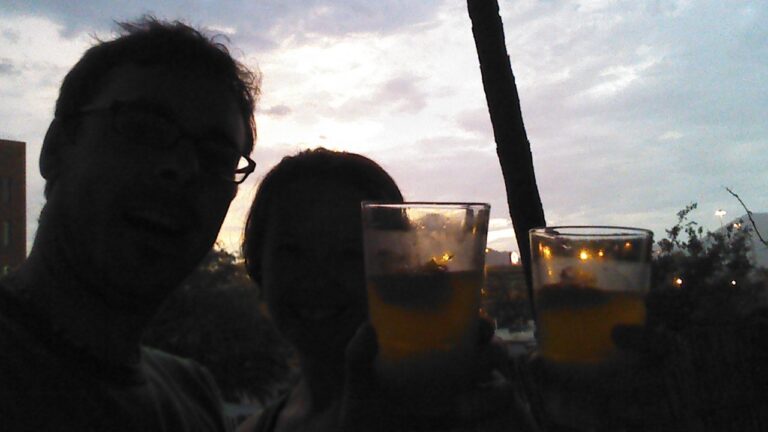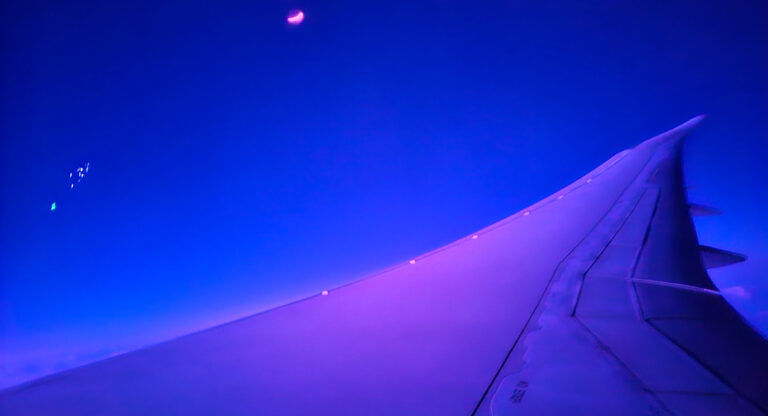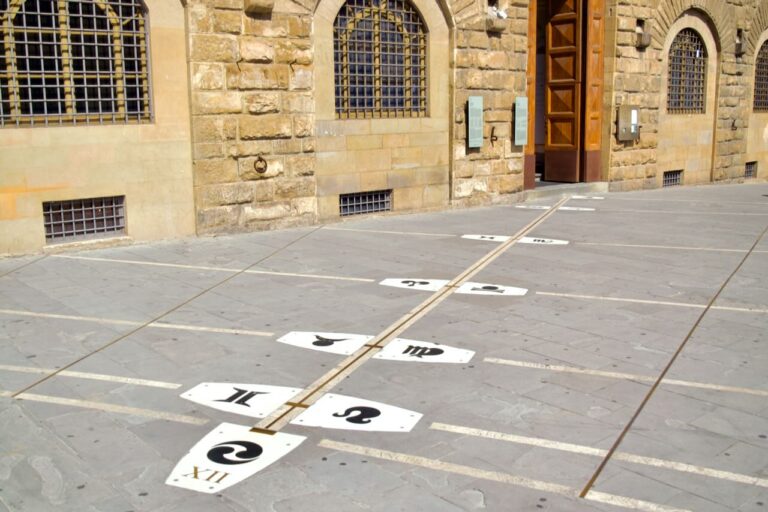Friday, September 6th | 2024 | Day 9
Deb and I had arranged to meet in the lobby for class at eight, only to realize our lesson was from two to five! After grabbing breakfast together at Il Ghiottone, I headed out to Palazzo Vecchio, again deciding not to stop first at the Medici chapel and San Lorenzo.
Right as I was crossing Piazza della Signoria, the bells chimed nine. Using my Firenze card for the ticket, I put my backpack in a locker, bypassed all the wonders I hadn’t seen on my first visit, and went directly to where the first group would be admitted to the tower.
About a dozen had gathered in a room with chairs and a TV where we watched a seemingly random promotional video of sights in and around Florence. After about ten minutes, one of the docents offered a “prego,” and gestured that we could start up the stairs.
Rising away from the splendor of the grand hall and private residences on the first two levels, the function of the Palazzo as a watchtower, prison, and military installation became much more apparent. The views were breathtaking—including those facing downward through a series of murder holes that would have allowed defenders to rain various forms of death onto besiegers in the piazza below.
As I reached the final crenelated wall of the bell tower, the sweeping panorama was even more spectacular. On the level below, one would have to walk to each side of the fortification to get a holistic picture. Here, you could turn on a dime and see it all. I started taking pictures facing north towards Santa Maria del Fiore, la Cappella de’ Medici, and San Lorenzo. Then turned west to capture this beautiful city as it extended down the Arno. Turning to the east, a docent who I hadn’t seen, was sitting in a nice shady spot on the other side of the staircase.
We got to talking—about Florence, her studies in Art History, what she thinks about modern art, and nearby towns that offer an even more authentic experience—vera Italia. I asked her if she had thought about traveling to the US and agreed when she said there was far more to see in Europe. At least through the lens of history and art, from ancient to modern.
This wasn’t the only conversation or sense I got of it while in Italy, but she told me how it had become too expensive for most Florentines to afford living in their own city. Priced out by an onslaught of wealthy foreigners buying up properties that become Airbnb rentals for tourists, rather than places for people who live and work here to call home.
It was heartbreaking to hear. I was just one dude, but contributing to it in some small way nevertheless. I did see absolute swarms wash through Piazza della Signoria. One of the main objections is that these large groups don’t stop for a coffee, gelato, or a meal—thereby contributing zero to the local economy. Nobody was disrespectful, but there were a lot of selfie sticks. I guess I just don’t understand the idea of going to any place for a few hours to check some “been there, done that” box.
When I started down the stairs, she turned to continue our conversation. I don’t remember what she asked, but “oh so reluctantly,” decided to stay. To get a video of the bells chiming at eleven, of course. Introducing ourselves, Eleanora said “I have something for you,” and pulled a brochure out of her bag. She unfolded it to reveal two stickers for a kind of scavenger hunt across Florence. Collecting all five allowed you to go on one of the special tours at the Palazzo free of charge.
It was such a sweet, heartwarming gesture that made me feel welcome and at home, even as a straniero. After making triple sure I wasn’t putting her out, she insisted. From the bottom of my heart, grazie mille, Eleanora. La pesca del Palazzo!
Keeping track as the top of the hour approached, I got a video of the bells ringing. One of the most magical aspects of Florence was hearing them toll across the city in unison. Tones that have rung out for ages , calling the faithful to mass, pealing in both celebration and alarm, while also politely reminding us of the time.
I said arrivederci to Eleanora and descended back to where I started.
The fountain of Jupiter on the left side of the building made for a great photo opp. It was also one of many locations throughout Florence where clean, safe drinking water is made available to the public. In summer, and especially during a heatwave, these offered welcome reprieve and much needed hydration.
After a few more minutes resting on the shaded steps, it was time to meet the group for lunch at Antico Ristorante Paoli.
The group enjoyed a remarkable meal. Antipasto featured oil and balsamic for dipping bread, along with fresh local cheeses. A wild boar sausage was slightly gamier in flavor than what is common in the US, but undoubtedly delicious. Primo was a bowl of cannelloni beans served in traditional Tuscan style with oil and salt, as well as large bowls of insalata to be passed and shared. For secondi, bistecca Fiorentina.
If you enjoy steak, this is a whole new level of experience. It was literally written on the wall that if you ask for yours to be prepared well-done, they will show you to the door. Thick slabs seared for only a few minutes on each side arrived at the table on a hot cast iron griddle supported by a wooden box. Cutting a bite or two, you put the less cooked side onto the griddle and after a few seconds, it is perfectly finished. The cut of Bistecca Fiorentina is also known as a porterhouse. Sirloin, or New York strip on one side of the bone, and tenderloin, or filet mignon on the other. So, the two best cuts in one massively mouthwatering serving.
Several around the table joked that we would all be in for a nap after such a heavy meal in the middle of the day. It was originally scheduled as one of our group dinners, but as one shift in arrangements cascaded into another, Nadia made sure we didn’t miss out on this truly unique and wonderful experience. All that protein was the fuel I was going to need for language class. The four of us set off from the restaurant and we of course stopped for a cappuccino at Antico Caffè Cavour, just to be certain nobody would fall asleep.
After class, Bill and Annae recommended stopping for a treat at La Gelateria. Specializing in simple, traditional flavors, each small batch is handcrafted from local ingredients. Availability and options likely change daily, as the black placards that made up the menu could easily be removed and replaced for fresh arrivals. Tre gusti di mango was just what the doctor ordered on another warm afternoon.
Deciding what to do next, I was delighted that Deb wanted to see the Cappella de’ Medici, so we headed off to ensure enough time before it closed for the day. To me, cappella, or chapel, implies somewhat small. As the place where most of the Medici lay at rest, it cannot be described as anything less than magnificent.
Upon entering what I would call the grand foyer, a series of cases full of reliquaries was off to the left. I found it a bit unsettling to see bones of once living mortals on display. By contrast, the exquisitely crafted gilt vessels that held their remains showed how deeply these saints and martyrs were revered and held sacred. There is also the aspect of having—or claiming to have—relics of a saint that was particularly popular or meaningful to the region, which would draw monetary contributions from both residents and pilgrims. Whether or not provenance can be proven, the true power of any relic lies in its impact and meaning on the lives of those who continue to have faith.
A bronze statue of Anna Maria Luisa de’ Medici stood on the opposite side of the foyer. Her head turned to the right and gaze cast downward, her expression was pensive, if not regretful. She was the last Medici. Perhaps bearing the weight of the world on her shoulders, or at least the world which her forebearers had struggled and fought for, now coming to an end.
Despite how she was depicted and the very subjective interpretation by the author, she certainly had vision. Naming the Duke of Lorraine heir to the Medici fortune, her only condition was: “that nothing of that which is of ornament to the State, of public utility or of interest in arousing foreigners’ interest shall be removed or taken out of the capital and State of the Grand Duchy.”
Basically, anything that was meaningful to Florence, was to remain there. Can you imagine the sheer number of wealthy buyers who would have absorbed priceless treasures meant to be enjoyed by the public into their private collections, effectively scattering the Renaissance to the four corners of the globe? If Giovanni, Cosimo, and Lorenzo—among many others—had built this family, she was the one who ensured its legacy remained intact, in a single place for all to see. Lift your eyes Anna Maria. Millions across generations around the world have you to thank.
Moving from the last Medici to the first, the tomb of Cosimo the Elder was around the corner. The simple room, without decorative embellishment of fresco or sculpture, was rather surprising for a man of his stature. Most striking however, was that the arches radiating from the mortuary curved to form the ceiling supporting San Lorenzo and the chapel above. As he was the foundation of the Medici family in life, so too he remained in death.
Going down into the mausoleum, or Sacristy, designed and carved by Michelangelo, it was more like entering a miniature Greek temple. Each tomb could have stood on its own as a masterpiece. Reposed on scrolled pediments, figures representing Dusk and Dawn, Night and Day, remind us that wealth and power can neither slow the great cycles of time nor prevent one’s imminent departure.
Again surprising due to his stature as “the Magnificent,” Lorenzo’s tomb was quite ordinary compared to other sarcophagi. It was also unexpected that he and his brother Guiliano are buried together. Atop the simple rectangular box of grey marble, a statue of the Madonna and Child was flanked by San Cosma and San Damiano, patron saints of the Medici family.
When Rome was sacked in 1527, Florence again rebelled against the Medici, and work on the Sacristy ground to a halt. Michelangelo resumed in 1531 once the Medici had been restored to power, but several other works vying for his talent, meant progress was much slower. In 1534, commissions in Rome called for his undivided attention and Michelangelo left Florence never to return.
Though some of the features Michelangelo set out to create weren’t finished, or even started, such as the wall tombs for Lorenzo and Guiliano, it was well worth a visit. I found it interesting to imagine the final hammer strike on the chisel echoing off of the marble before falling silent, as the hands of that great master came to rest for the last time in this place. Personally, seeing where Lorenzo is buried and taking a few moments of silence to say, “grazie per tutti,” was very important to me.
Without much time before it closed for the evening, our last stop was the Medici Chapel. Clad from floor to ceiling in green and red porphyry inlaid with semi-precious stone and jewels—pietra dura—made the opulent space feel richer and warmer than churches largely constructed from white stone. The octagonal layout was punctuated by monuments commemorating Grand Dukes Ferdinand I, Cosimo I, II and III, and Francesco I. Underneath, the ornately carved sarcophagi remain empty as earthly remains are relegated to crypts beneath the church.
From the outside, the dome was a prominent feature of the skyline, though covered by terra cotta tiles that blended in with the surrounding city. The interior was nothing short of spectacular. Pivotal scenes and prophets from the Old and New Testaments were honored in fresco, surrounded by lavishly carved and gilded frames. An oculus pierced the top, allowing light to shine down onto the altar.
Once the staff told us it was time to go, Deb and I roamed towards the Duomo. Rather than revisiting Move On, we decided to continue on to Piazza della Repubblica for something new.
Rinascente is a high end department store that faces the square. We were not there to shop and made a bee line for the elevator up to the rooftop bar. They don’t take reservations so the wait can be rather long, but we got lucky at only twenty minutes. The sunset view was wonderful and well worth it. I didn’t feel like digging my camera out, but got some decent shots and panoramas with my phone.
After a spritz and some nibbles, we were both in the mood for something lighter than steak and ordered salads and a bottle of white. I really enjoyed our conversations that evening, which flowed seamlessly and went a little deeper than surface level small talk. She gave some good advice and helped me realize that I needed and deserved more than a situationship. Easier said than done of course, but as one is often blind to the obvious, I always appreciate the perspective of someone looking from the outside in.


